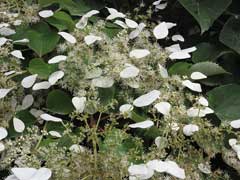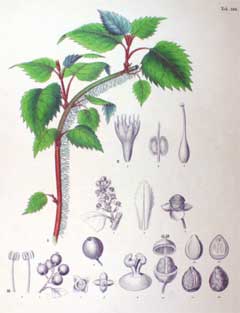 |
|
http://commons.wikimedia.org/wiki/User:Cillas |
 |
| http://commons.wikimedia.org/wiki/File:Schizophragma_hydrangeoides_SZ100.png |
Translate this page:
Summary
Bloom Color: White. Main Bloom Time: Early spring, Late spring, Mid spring. Form: Irregular or sprawling.
Physical Characteristics

 Schizophragma hydrangeoides is a deciduous Climber growing to 12 m (39ft) by 12 m (39ft) at a slow rate.
Schizophragma hydrangeoides is a deciduous Climber growing to 12 m (39ft) by 12 m (39ft) at a slow rate.
See above for USDA hardiness. It is hardy to UK zone 5. It is in flower from July to September. The species is hermaphrodite (has both male and female organs) and is pollinated by Insects.
Suitable for: light (sandy), medium (loamy) and heavy (clay) soils. Suitable pH: mildly acid, neutral and basic (mildly alkaline) soils. It can grow in full shade (deep woodland) semi-shade (light woodland) or no shade. It prefers moist soil.
UK Hardiness Map
US Hardiness Map
Synonyms
Plant Habitats
Woodland Garden Dappled Shade; Shady Edge; not Deep Shade; Ground Cover; North Wall. By. East Wall. By.
Edible Uses
Edible Parts: Leaves
Edible Uses:
Leaves - cooked[105, 177].
References More on Edible Uses
Medicinal Uses
Plants For A Future can not take any responsibility for any adverse effects from the use of plants. Always seek advice from a professional before using a plant medicinally.
None known
References More on Medicinal Uses
The Bookshop: Edible Plant Books
Our Latest books on Perennial Plants For Food Forests and Permaculture Gardens in paperback or digital formats.

Edible Tropical Plants
Food Forest Plants for Hotter Conditions: 250+ Plants For Tropical Food Forests & Permaculture Gardens.
More

Edible Temperate Plants
Plants for Your Food Forest: 500 Plants for Temperate Food Forests & Permaculture Gardens.
More

More Books
PFAF have eight books available in paperback and digital formats. Browse the shop for more information.
Shop Now
Other Uses
Plants can be allowed to sprawl and are then used as a ground cover for a shady position[188, 208].
Special Uses
Ground cover
References More on Other Uses
Cultivation details
Landscape Uses:Arbor. Requires a moist leafy soil and some shade at the roots. An easily grown plant[1], it prefers a good loamy soil and plenty of moisture[11]. Succeeds on most soil types, disliking only very alkaline soils[202]. Plants succeed in sun or shade[182], though they prefer full sun[202, 219]. In the hotter parts of Britain they prefer shade from the midday sun[219]. They succeed on north-facing walls[188, 219]. The fully dormant plant is hardy to about -20°c[182, 200]. Plants are slow to establish and slow-growing when young, though they speed up somewhat with age[202]. Plants do not normally require pruning, though any unwanted growth can be removed in the winter[219]. Plants have a similar growth habit to ivy (Hedera helix) climbing trees by means of aerial roots or growing along the woodland floor[1, 182]. Plants might need some help to become attached in their early years[182]. Some named varieties have been developed for their ornamental value[182]. Special Features:Not North American native, Attractive flowers or blooms.
References Carbon Farming Information and Carbon Sequestration Information
Temperature Converter
Type a value in the Celsius field to convert the value to Fahrenheit:
Fahrenheit:
The PFAF Bookshop
Plants For A Future have a number of books available in paperback and digital form. Book titles include Edible Plants, Edible Perennials, Edible Trees,Edible Shrubs, Woodland Gardening, and Temperate Food Forest Plants. Our new book is Food Forest Plants For Hotter Conditions (Tropical and Sub-Tropical).
Shop Now
Plant Propagation
Seed - sow late winter to early spring in a greenhouse. Germination is usually fair to very good[78]. Prick out the seedlings into individual pots once they are large enough to handle and grow them on in light shade in the greenhouse for their first winter, planting them out in late spring or early summer. Layering in spring directly into pots. A fair to good percentage[78], though it can be difficult to find suitable low growth[202]. Cuttings of half-ripe wood, 4 - 5cm with a heel, July in a frame[1, 78]. Keep the cuttings moist[78].
Other Names
If available other names are mentioned here
Native Range
TEMPERATE ASIA: Japan (Hokkaidô, Honshu, Kyushu, Shikoku), Korea, South
Weed Potential
Right plant wrong place. We are currently updating this section.
Please note that a plant may be invasive in one area but may not in your area so it's worth checking.
Conservation Status
IUCN Red List of Threatened Plants Status :

Growth: S = slow M = medium F = fast. Soil: L = light (sandy) M = medium H = heavy (clay). pH: A = acid N = neutral B = basic (alkaline). Shade: F = full shade S = semi-shade N = no shade. Moisture: D = dry M = Moist We = wet Wa = water.
Now available:
Food Forest Plants for Mediterranean Conditions
350+ Perennial Plants For Mediterranean and Drier Food Forests and Permaculture Gardens.
[Paperback and eBook]
This is the third in Plants For A Future's series of plant guides for food forests tailored to
specific climate zones. Following volumes on temperate and tropical ecosystems, this book focuses
on species suited to Mediterranean conditions—regions with hot, dry summers and cool, wet winters,
often facing the added challenge of climate change.
Read More
Expert comment
Author
Siebold.&Zucc.
Botanical References
1158200
Links / References
For a list of references used on this page please go here
Readers comment
© 2010, Plants For A Future. Plants For A Future is a charitable company limited by guarantee, registered in England and Wales. Charity No. 1057719, Company No. 3204567.